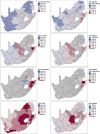Assessing the geographical distribution of comorbidity among commercially insured individuals in South Africa
- PMID: 33198704
- PMCID: PMC7667849
- DOI: 10.1186/s12889-020-09771-6
Assessing the geographical distribution of comorbidity among commercially insured individuals in South Africa
Abstract
Background: Comorbidities are strong predictors of current and future healthcare needs and costs; however, comorbidities are not evenly distributed geographically. A growing need has emerged for comorbidity surveillance that can inform decision-making. Comorbidity-derived risk scores are increasingly being used as valuable measures of individual health to describe and explain disease burden in populations.
Methods: This study assessed the geographical distribution of comorbidity and its associated financial implications among commercially insured individuals in South Africa (SA). A retrospective, cross-sectional analysis was performed comparing the geographical distribution of comorbidities for 2.6 million commercially insured individuals over 2016-2017, stratified by geographical districts in SA. We applied the Johns Hopkins ACG® System across the insurance claims data of a large health plan administrator in SA to measure comorbidity as a risk score for each individual. We aggregated individual risk scores to determine the average risk score per district, also known as the comorbidity index (CMI), to describe the overall disease burden of each district.
Results: We observed consistently high CMI scores in districts of the Free State and KwaZulu-Natal provinces for all population groups before and after age adjustment. Some areas exhibited almost 30% higher healthcare utilization after age adjustment. Districts in the Northern Cape and Limpopo provinces had the lowest CMI scores with 40% lower than expected healthcare utilization in some areas after age adjustment.
Conclusions: Our results show underlying disparities in CMI at national, provincial, and district levels. Use of geo-level CMI scores, along with other social data affecting health outcomes, can enable public health departments to improve the management of disease burdens locally and nationally. Our results could also improve the identification of underserved individuals, hence bridging the gap between public health and population health management efforts.
Keywords: Comorbidity index; Geographical distribution; South Africa.
Conflict of interest statement
The authors declare that they have no competing interests.
Figures




References
-
- Hyder, A.A., Puvunachandra, P., & Morrow, R. (2012) In Merson MH, Black RE, Mills AJ. Global health : diseases, programs, systems, and policies. Measures of health and disease in populations. In: 3. ed. Sudbury Mass.: Jones & Bartlett Learning; 2012:936.
MeSH terms
LinkOut - more resources
Full Text Sources
Medical
Miscellaneous

